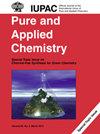Unraveling the influence of biomaterial’s functional groups in Cd biosorption: a density functional theory calculation
IF 2
4区 化学
Q3 CHEMISTRY, MULTIDISCIPLINARY
引用次数: 0
Abstract
Several biomass wastes, including forest wastes, bagasse, algae, and others, have been studied to determine their biosorption capability for adsorbing different ranges of heavy metals in the literature. Most experimental studies have not clearly shown the impact of functional groups in biomaterials discovered by FTIR analysis on the investigated biosorption processes. Because of this, the findings of this study indicate that it is necessary to theoretically investigate the influence of identified functional groups (as determined by FTIR analysis) on the biosorption activities of the sorbent or biomaterial prepared for the removal of cadmium metal from an effluent. Using the most geometrical structure for cadmium (Cd) metal, a series of identified functional groups for the sorbent were analyzed using FTIR to determine their mode and intensity of interaction to computationally understand better how they each influence the biosorption of cadmium. This was done to determine how each functional group contributes to the intensity of the cadmium biosorption, using a ground-state B3LYP density functional theory calculation performed in a Spartan 20 simulation package utilizing the 6-31G* and LANL2DZ > Kr basis sets. According to the study’s findings, carboxylate (–COO*) had the most significant effect on cadmium biosorption activity of all the functional groups studied due to the stronger binding strength obtained for it. Therefore, this research suggests exploring biomaterials with greater intensity for carboxylate function, which would aid cadmium sorption efficiency in an effluent treatment process.揭示生物材料官能团在镉生物吸附中的影响:密度泛函理论计算
文献中研究了多种生物质废物,包括森林废物、甘蔗渣、藻类等,以确定它们吸附不同范围重金属的生物吸附能力。大多数实验研究都没有清楚地表明通过傅立叶变换红外分析发现的生物材料中的官能团对所研究的生物吸附过程的影响。因此,本研究的结果表明,有必要从理论上研究已确定的官能团(通过傅立叶变换红外光谱分析确定)对为去除污水中的金属镉而制备的吸附剂或生物材料的生物吸附活性的影响。利用金属镉(Cd)的最几何结构,使用傅里叶变换红外光谱分析了吸附剂中一系列已确定的官能团,以确定它们的相互作用模式和强度,从而通过计算更好地了解它们各自是如何影响镉的生物吸附的。在 Spartan 20 仿真软件包中利用 6-31G* 和 LANL2DZ > Kr 基集进行了基态 B3LYP 密度泛函理论计算,从而确定了每个官能团对镉生物吸附强度的影响。研究结果表明,在所有研究的官能团中,羧酸盐(-COO*)对镉的生物吸附活性影响最大,因为它的结合强度较强。因此,这项研究建议探索羧酸盐功能强度更大的生物材料,这将有助于提高污水处理过程中的镉吸附效率。
本文章由计算机程序翻译,如有差异,请以英文原文为准。
求助全文
约1分钟内获得全文
求助全文
来源期刊

Pure and Applied Chemistry
化学-化学综合
CiteScore
4.00
自引率
0.00%
发文量
60
审稿时长
3-8 weeks
期刊介绍:
Pure and Applied Chemistry is the official monthly Journal of IUPAC, with responsibility for publishing works arising from those international scientific events and projects that are sponsored and undertaken by the Union. The policy is to publish highly topical and credible works at the forefront of all aspects of pure and applied chemistry, and the attendant goal is to promote widespread acceptance of the Journal as an authoritative and indispensable holding in academic and institutional libraries.
 求助内容:
求助内容: 应助结果提醒方式:
应助结果提醒方式:


